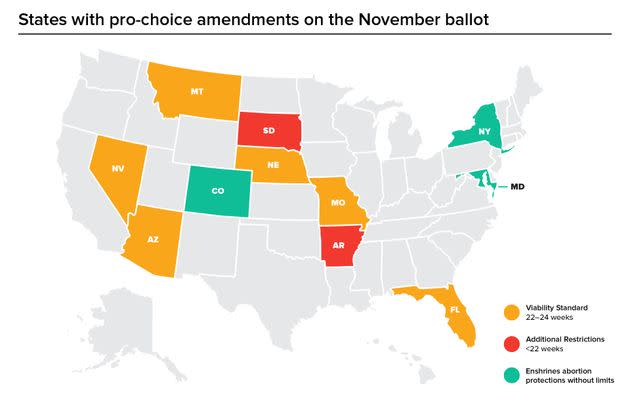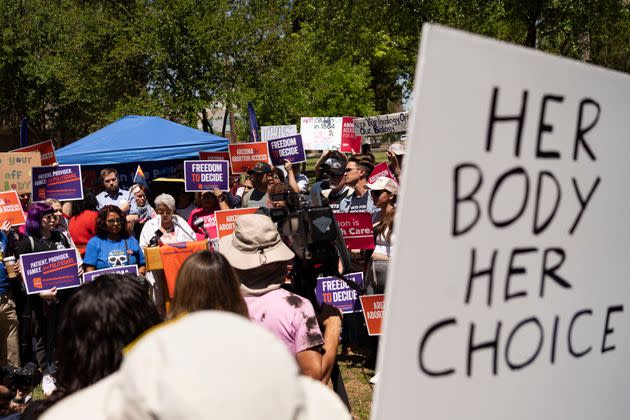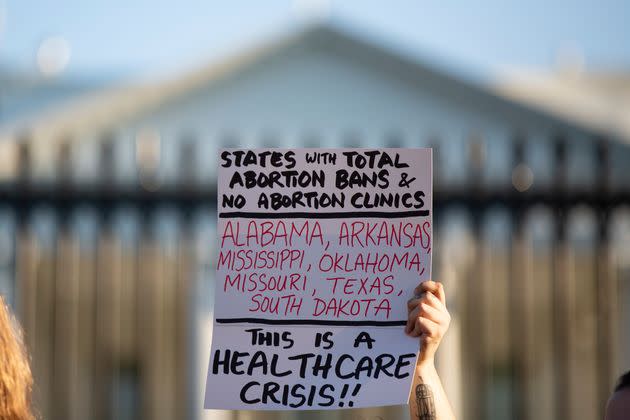Why Some Abortion Rights Groups Aren’t Backing Pro-Choice Amendments

Eloisa Lopez is the executive director for Pro-Choice Arizona and the Abortion Fund of Arizona, one of only three funds in the state. She sits on the state’s maternal mortality committee. She escaped an abusive relationship when she was pregnant with her second child and has had four abortions. Lopez knows that abortion access can be a critical lifeline.
That’s why, she says, she can’t support the pro-choice constitutional amendment that will likely be on the Arizona ballot in November.
The ballot measure, created by Arizona for Abortion Access, would establish a fundamental right to abortion until fetal viability, somewhere between 22 to 24 weeks, in the state constitution. Lopez’s main concern is that enshrining the Roe v. Wade standard in Arizona’s constitution would protect abortion until viability but leave the door open for legislators to restrict care after that point.
“We don’t support a viability standard,” Lopez told HuffPost. Both of Lopez’s organizations were involved in initial committee conversations with Arizona for Abortion Access, but once it became clear that the initiative was supporting a viability standard, not a general fundamental right, Lopez withdrew her support.
“We’re not interested in compromising,” she said. “You’re asking the state to give you permission to a certain degree but then leaving it to the state to criminalize you after that point.”
Not everyone agrees. Dawn Penich, the communications director for Arizona for Abortion Access, argued that the urgency to restore abortion access right now is critical ― even if it’s only until viability. The state currently has a 15-week abortion ban and is staring down a near-total ban since the state Supreme Court ruled this month that an 1864 law banning abortion can take effect.
“None of this matters if the Arizona voter doesn’t support it, and it became very clear that viability was a reasonable limit that voters would approve,” Penich said. “We felt like the viability standard fit the Arizona ethos and the Arizona consciousness around the right place to put those limits.”

This is the struggle playing out right now in many states where abortion rights will likely be on the ballot. Some abortion rights advocates, like Lopez, believe the country should be thinking bigger than Roe because lawmakers were still able to chip away at access under that standard, and it left out the often overlooked patients who need care later in pregnancy. Others, like Penich, think that perfect shouldn’t be the enemy of good and that some access is better than none.
And the abortion rights movement is grappling with this issue during what is possibly the most critical moment for abortion care since Roe was decided in 1973, as nearly 20 states now have abortion bans in effect.
*****
Ballot measures have been a highly successful response to restrictions on abortion access since the U.S. Supreme Court overturned Roe v. Wade on June 24, 2022. Referendums on abortion rights prove that when people are given the ability to vote directly on abortion, they vote pro-choice.
But ballot measures take an immense amount of time, money and legwork. And unlike laws, which can be edited over time, most states will only get one shot at passing an abortion rights amendment. The importance of crafting the right language with the appropriate protections in this moment cannot be overstated.
Ten states may have abortion rights amendments on the November ballot ― the most ballot initiatives ever in one election cycle. Six states include a viability standard; two others, Arkansas and South Dakota, include protections up to 18 weeks and 13 weeks, respectively. Colorado and Maryland are the two states without viability standards; one seeks to bar government interference in pregnancy decisions and the other will enshrine the right to choose to continue or end a pregnancy. An 11th state, New York, may also have a ballot measure to expand the Equal Rights Amendment to include pregnancy and pregnancy outcomes.
As of this month, Florida will have a pro-choice amendment on the November ballot that includes protections until 24 weeks of pregnancy. Several other states with viability standards still need to gather a required amount of valid signatures, the number and deadlines of which vary state by state. Many, including Arizona, Montana and Colorado, are expected to meet their requirements.

Meanwhile, a handful of states are working to get enough signatures to include anti-abortion amendments on the ballot. Missouri and Nebraska are the most likely of the bunch to meet the requirements.
It’s a tough and frustrating debate for both sides during what could be a turning point for abortion rights. “Having a total ban affects more people than having a viability limit,” said Katrina Kimport, a researcher with Advancing New Standards in Reproductive Health (ANSIRH) whose current research focuses on third-trimester abortions. “But viability is just a ban at a later point in pregnancy.”
‘We’ve Seen How Roe Wasn’t Enough’
Erika Christensen thought abortion access until viability sounded reasonable until she was given a fatal fetal diagnosis in her third trimester in2016. Christensen wasn’t able to get an abortion in her home state of New York, and she and her husband had to travel to Colorado to get care.
Christensen, who now lives in Arizona, believes the stigma around later abortion care is at the root of these viability standards. “Modern later abortion care is safe, it’s ethical and, for the people who need it, it’s a miracle,” she said. Christensen and her husband founded the abortion strategy and advocacy group Patient Forward.
“I think it’s possible for the public to feel uncomfortable about something and want it to be available for them and their loved ones,” she said. “I hope that we stop writing policies based on discomfort and write policies based on health and safety.”
Christensen says that viability standards are not necessarily a community education problem but a lack of political will on the side of state-led initiatives. A 2023 poll from PerryUndem, a nonpartisan research firm, suggested that a majority of abortion rights supporters favor ballot initiatives without viability limits over initiatives with viability limits. The finding is in line with other research from recent years that suggests pro-choice voters have become more supportive of unrestricted abortion access.
It’s not that simple for advocates in Arizona, Penich said. Arizona for Abortion Access, a coalition of reproductive rights groups and democracy organizations, have worked tirelessly to craft the language included in the state’s abortion rights initiative. They landed on the point of viability, but some people are still unhappy, Penich said, adding that they also had groups advocating for less than 24 weeks.

Penich also pointed to Arizona’s high threshold to get an amendment on the ballot. The coalition needs to get about 384,000 validated signatures for the measure to then be sent to the secretary of state and the Arizona Legislature for approval. Although they currently have about 500,000 signatures, they’re shooting to get 800,000 before the July 3 deadline in anticipation of legal challenges from the Republican-majority legislature.
Arizona has historically been hostile toward direct democracy initiatives. One rule currently in place requires that the signatures on the list of names do not touch one another. For example, if someone has a J in their name and the J swoops under the signature line and overlaps with the person’s signature underneath theirs, both signatures are invalid.
“It’s a constant stream of attacks,” Penich said. “The calculus in developing this language is that nothing exists in a silo. Knowing that process… about all of the opportunities to challenge the language, write the ballot language ― all of that has to be taken and looked at in concert.”
Arizona isn’t the only place where some pro-choice groups have decided to withhold support from ballot measures because they don’t believe the protections go far enough. In South Dakota, major players, including the regional Planned Parenthood and American Civil Liberties Union, are speaking out against a ballot measure that another local group is championing.
Dakotans for Health, a grassroots group that organizes progressive ballot measures, created a ballot initiative to enshrine abortion access in the state constitution through the first trimester, or 13 weeks of pregnancy, and impose restrictions in the second and third trimesters, similar to those included in the original 1973 Roe decision. The measure is more restrictive than other ballot initiatives that include viability limits. Although it is not written to be a 13-week ban, in practice its language could amount to one given that after the first trimester, the state Supreme Court — one of the most conservative in the country — would need to weigh in.
The organization told HuffPost it had enough signatures to get the amendment on the ballot in November.
But critics see the measure as a nonstarter and worry about that restriction being adopted by South Dakota long-term, even though the state now has a near-total abortion ban with no exceptions for pregnancies caused by rape or incest.
“We are not a coalition member of the ballot campaign in South Dakota,nor part of the language drafting process. The amendment as drafted will not adequately reinstate the right to abortion,” Tim Stanley, vice president of public affairs for Planned Parenthood North Central States, told HuffPost in a statement.
Having a total ban affects more people than having a viability limit. But viability is just a ban at a later point in pregnancy.Katrina Kimport, Advancing New Standards in Reproductive Health
Kim Floren has also been vocal about her opposition to the amendment. Floren works at what was the only abortion clinic in the state before Roe v. Wade fell, and she co-founded one of South Dakota’s few abortion funds, the Justice Empowerment Network (JEN).
“We’ve seen how Roe wasn’t enough,” Floren said. Even when federal protections were in effect, South Dakota had zero full-time providers because of state-level restrictions. She sent about 70% of her JEN patients out of state for care, while the rest were seen by providers who flew in from other states to treat patients.
“So many people that we help now are further along ― in their second or third trimester ― and as an organization that works directly with those patients so often, it just feels like we would be betraying them,” Floren said, referring to her work with JEN. “It’s really hard to support anything that leaves those patients out.”
Rick Weiland, chairman of Dakotans for Health, argued that there has never been a more urgent time to restore abortion access. Almost 93% of abortions reported to the Centers for Disease Control and Prevention in 2020 were done before the 13th week of pregnancy.
“We have no abortion access right now,” Weiland told HuffPost. “In a state like South Dakota, using the Roe framework is a way for us, we believe, to confidently provide access to 99% of women.”
Floren and other advocates opposing the measure claim that Dakotans for Health didn’t include them during initial conversations when crafting the language of the ballot initiative. Weiland disputed those claims and instead said Planned Parenthood and the ACLU were not responsive. He emphasized just how urgent it is to restore abortion access in a state that currently has a near-total abortion ban. Weiland believes this amendment will do that if pro-choice voters can come together to pass it.
But many believe that the urgency to restore abortion access is what’s causing a major misstep. The pro-choice movement is effectively cutting off its nose to spite its face, several advocates told HuffPost. Some think that groups behind ballot measures should take more time to research and educate the public before bringing an option to voters that will affect abortion care for decades to come.
“The truth is that those states [with viability standards] have decided the question is not whether the government has a right to your body but when the government has a right to your body,” Christensen said.
“Whether you draw a line at 15 weeks, 20 weeks, 24 weeks ― there’s no point in pregnancy that the state is better positioned to make decisions about our pregnancies than we are,” she said. “At some point you lose your right to autonomy ― that is what we’re enshrining.”
‘We Are Trying To Survive’
Not every state has the luxury of time. Lauren Brenzel, the campaign director for Floridians Protecting Freedom, the coalition behind the state’s pro-choice amendment, is bracing for a six-week abortion ban to go into effect this week. Florida currently has a 15-week abortion ban in place, and it’s the only haven for care in the entire Southeast. The abortion rights amendment, which seeks to provide a constitutional right to abortion before fetal viability, would be a huge lifeline for an entire region of the country.
“We are trying to survive,” Brenzel told HuffPost. “We are trying to do what’s best for our people, and we are leading a strategy that is embedded within the state, that our state advocates and activists are aligned upon, and that is going to return care to 84,000 patients.”
We are trying to survive. We are trying to do what’s best for our people, and we are leading a strategy that... is going to return care to 84,000 patientsLauren Brenzel, Floridians Protecting Freedom
With a Republican supermajority, Florida has some of the highest thresholds for getting a ballot measure approved. Floridians Protecting Freedom had to get 891,523 validated signatures and meet thresholds in half of the state’s 28 congressional districts, all of which they had to get done between May and Dec. 1, 2023, since the legislature does not allow petition signatures to roll over into the next year. The group then had to get the ballot language approved by one of the most conservative state Supreme Courts in the country. And even though the measure will be on the 2024 ballot ― a huge victory for abortion rights advocates ― it must get at least 60% of the vote rather than a simple majority.
The three states with the most hostile legislatures when it comes to direct democracy are Florida, Missouri and Arizona, Chris Melody Fields Figueredo told HuffPost. Fields Figueredo is the executive director of the Ballot Initiative Strategy Center, which recently hosted a conference where many of the campaign leaders for pro-choice ballot measures came together to discuss strategy.
“Florida definitely has the highest threshold in the country,” she said. “Arizona’s state legislature has been trying to undermine the power of our measures ― in Missouri, too ― for a number of legislative sessions.”

Floridians Protecting Freedom raised nearly $19 million, almost all of which was spent on collecting petition signatures, Brenzel said. For context, Weiland in South Dakota has raised around $400,000 and needs to get just over 35,000 signatures. And in Arizona, Penich and her team have raised more than $12 million and need to get about 384,000 valid signatures. Of course, Florida is the largest state by population, but the stark contrast shows how much the requirements can vary state by state and how that informs ballot language.
“The people who developed this really care about Florida and protecting Floridians,” Brenzel said. “It was via coalition that we designed our language. It was via coalition and state individuals that we defended our language. It was via coalition and state support that we got this on the ballot. And we’re going to do our due diligence as a state-led coalition to pass this initiative.”
‘Dream Bigger’
Some advocates backing Roe standards in their state pointed to the fact that President Joe Biden is running on a “Restore Roe” campaign, and many of the national organizations, including Planned Parenthood, the ACLU and Reproductive Freedom For All, have endorsed it.
The National Institute for Reproductive Health, another large reproductive rights organization, is one group that has not fallen in line with the viability standard. “The problem with viability limits and any other limits that we’re talking about in the provision of abortion care is that it’s introducing or seeding the grounds that government still has a role in controlling people’s decisions about their pregnancy,” said Bonyen Lee-Gilmore, the group’s vice president of communications.
“When I hear [Biden] say ‘restore Roe,’ I hear a wider movement toward acceptance of normalizing all of these harms that we’ve experienced for five decades,” she added.
When federal abortion protections were still intact, women routinely had to travel across state lines to get care later in pregnancy, and many others were criminalized for their pregnancy outcomes. From 2006 to June 2022, nearly 1,400 criminal arrests took place for things like using illicit substances while pregnant, as well cases over things like not wearing a seatbelt, not getting prenatal care and having HIV while pregnant.
The viability framework allows personhood interpretations of the fetus after that viability limit, Lee-Gilmore explained. This means that a pregnant person’s rights diminish the closer they get to birth, and the “rights” of a fetus are often prioritized. In theory, it makes sense that a mother would want to prioritize her baby, but in practice it can result in horror stories, like the New York woman who underwent a C-section against her will in 2011.
The problem with viability limits... is that it’s introducing or seeding the grounds that government still has a role in controlling people’s decisions about their pregnancy.Bonyen Lee-Gilmore, National Institute for Reproductive Health
Just last year, an Ohio judge used the viability standard included in the state’s successful pro-choice amendment to charge a woman with felony abuse of a corpse after she miscarried and the fetus dropped into a toilet. Viability, a vague and manufactured legal standard, can be anywhere from 22 to 24 weeks; the Ohio woman was 21 weeks and five days pregnant.
“The question of whether that fetus has rights over the pregnant person is what the viability limit is inviting,” Lee-Gilmore said.
One practical step every state can take right now to better protect pregnant people is to repeal personhood statutes in criminal codes, Lee-Gilmore said. Removing these statutes would curb some threat of criminalization post-viability.
As an alternative to viability standards, Lee-Gilmore pointed to the initiatives in New York and Colorado as great blueprints. Colorado’s initiative seeks to prohibit state or local governments from denying abortion care at any point in pregnancy, and it allows abortion to be covered by health insurance plans. New York’s initiative is something no state has ever done before: It seeks to add “pregnancy, pregnancy outcomes, and reproductive healthcare and autonomy” to the state’s equal rights amendment.
For those states that are already working with viability standards in ballot language, Lee-Gilmore hopes that, moving forward, the pro-choice movement will “build policies that center the patients and not our opposition.”
NIRH recently launched the Learning and Accountability Project to focus on this very issue. The nationwide project includes educational campaigns for the public and legal training for people within the reproductive justice movement, and it compiles data and research that support building more expansive abortion policies to include later care.
Lopez, from Arizona, knows what it’s like to have to start over. As a survivor of domestic violence, she lost everything: her family, her home and her career, and she’s still battling her abusive ex-partner in court. Everything since then has been a stepping stone, but she refuses to settle ― a quality she loves about abortion fund networks.
“When shit hits the fan and we’re seeing so many abortion bans ― the entire South has lost access ― we are still committed to making it possible for people,” she said. “I’m so appreciative that abortion funds dream big.”
“But fear is what’s driving compromise, and people are settling right now,” Lopez said. “There’s a lack of being able to dream bigger.”
CORRECTION: This article has been updated to reflect that Kim Floren was referring to patients from the Justice Empowerment Network, not Planned Parenthood, when referring to sending patients out of state.

